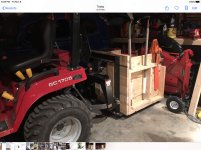Given the flat sides of the ballast box you already have, I'd be tempted to bolt 2" receiver hitches to the left, right and rear sides and either use one of Heavy Hitch's 2" receiver weight brackets or use the 2" receiver to add some other form of modifiable weight/ballast.
That would allow for tailoring the weight of the ballast for the conditions/work --- as well as providing additional tool mounting locations.
This is a very cool idea. I had been thinking down the path of just buying one or two more ballast boxes, to load at different weights, but that creates a little storage headache. Your solution solves that, but is harder on the back than just backing up to a different box with a quick hitch. Both options to consider...
Not sure what you expected???
I sort of expected the range of opinions I'm seeing, I know this is not a new subject here. Just fishing for more opinions, keep 'em coming, I've gotten some great ideas from this crowd already.
I would try it for a year with no added weight on the tractor so that you can get into the yard during the "soft" season and see how it workes out. But I would also get the big ballast box and fill it to about 3/4 full and as heavy as possible. When you need more ballast, fill the remaining 1/4 of the box with steel.
The ballast box for my 2720 weighs 600 lbs or 800 lbs, depending on the job and ground condition.
I don't think you can ever underestimate the need for ballast. Is the cost of the larger box prohibitive? Try the smaller box. If it is not sufficient, get the bigger one, but fill with sand. Then you can find the sweet spot of how much ballast works for you to balance the need for ballast vs the need not to rut up your yard. Then once you know that limit, remove sand and put in the same weight of concrete if you feel the need.
Both of these posts echo similar advice, skip weight in the wheels for now, and put what I need on the hitch. I'd be looking at a 2000 lb. ballast box to hit the capacity of this loader, and it could work fine on flat land, my only concern with this plan would be side-hill stability. I have to traverse side hill quite a bit on this machine, sometimes with a load of mulch in the bucket (albeit, not the heaviest load...).
... and no, the cost of a larger box is less than 1% of the cost of this tractor! I'd be fine with the cost of multiple ballast boxes, which might be the direction I'm headed here. Just gotta figure out a good way to store them out of the weather, and keep them accessible.
I would start out with ballast you have and go from there.... Tractor will tell you if it wants more....
I'm trying to avoid that very situation! My wife has told me I'm not a great listener, what if I don't hear the tractor until she screams? :laughing:
Seriously, I got the rear of my 855 so light once that it went freewheeling down a hill with me on it. A mistake I won't repeat, but I've also had logs roll in unexpected ways once or twice, pulling the rear tires off the ground. The capacity and reach of this loader versus the wheelbase and weight of the tractor is such that this new rig will be 2.3x more "tippy" than the old 855, using a simple length*weight see-saw equation with the front axle as the fulcrum.

